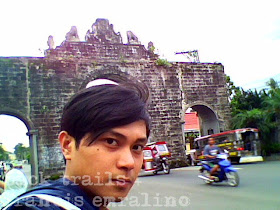A note as you enter the town of Pagsanjan (through the Puerta Real) summarizes the history of the place. It was once a barrio of Lumbang* (now Lumban, Laguna) and later organized into a separate municipality (or into a town?) in 1668. A certain Francisco Umali became its first gobernadorcillo. It later became La Laguna’s capital from 1688 to 1858.** 1896 brought the revolutionists to the place. By 1899, the Americans came as a result of the American occupation of the country. The Japanese occupied the town in 1942 and later reclaimed by the Filipinos towards the end of World War II in 1945.
The town gate was originally constructed between 1878 and 1880. Its inauguration was graced by the presence of Don Pedro Paterno. Restoration of the gate was done under the administration of Gregorio Zaide, the famous historian and writer.
Looking into the possible origin of the town’s name, it seems that Pagsanjan is an ‘evolution’ of the word “Pinagsangahan”, or the place where a river branches out. A survey of the bodies of water in the place would confirm this, and I hope to share it in the coming entries.
* It may be implied that Lumban was once a big place. But Pagsanjan may be larger now than Lumban. I am yet to check for this. The town of Rosario in Batangas suffered unfortunately from such similar divisions, for some important structures (such as the old Rosario church found now in Padre Garcia) were ‘given’ to the separating town. A visit to Lumban I think would be instructive regarding their subdivisions.
** Better update myself on the transfer of capitals. I initially thought that after Bay, Sta. Cruz became the capital up to the present.
[How to go to Pagsanjan, Laguna: From Manila, board a bus bound for Sta. Cruz, Laguna via College and Calamba. Buses can be found along EDSA and on Gil Puyat LRT Station. Drop off Sta. Cruz, or you can wait until the bus enters the terminal which is already within the Pagsanjan (in barangay Biñan). Then hail a jeep bound for Pagsanjan. Note that if you plan to go to Pagsanjan Falls, the road leading to it is found on the right side of the main road, before you reach the town proper.]


"It later became La Laguna’s capital from 1668 to 1858."
ReplyDeleteHello Pransism.
I'm currently doing some research on the web about this town, that's why I stumbled upon your blog. Just a slight correction: Pagsanján was the capital of La Laguna from 1688 to 1858, a period of 170 years. Best regards. Nice job you're doing by the way.
Pepe Alas
Hello Sir Pepe. Thanks for dropping by my blog and the correction. I've known you and your friend Arnaldo through your blogs. Hope I get to meet you one of these days. Salamat!
ReplyDelete